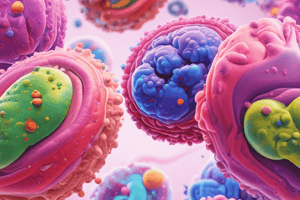Podcast
Questions and Answers
What is the estimated prevalence of STIs in the US?
What is the estimated prevalence of STIs in the US?
- 1 in 5 people (correct)
- 1 in 50 people
- 1 in 20 people
- 1 in 10 people
Which of the following is a parasitic STI?
Which of the following is a parasitic STI?
- HIV
- HPV
- Pubic lice (correct)
- Chlamydia
What is a common symptom of STIs?
What is a common symptom of STIs?
- Nausea and vomiting
- Pain or burning during urination (correct)
- Fatigue and muscle weakness
- Fever and headache
How can STIs be prevented?
How can STIs be prevented?
What is the primary method of diagnosing STIs?
What is the primary method of diagnosing STIs?
Which of the following is a viral STI?
Which of the following is a viral STI?
What is the primary treatment for bacterial STIs?
What is the primary treatment for bacterial STIs?
What is a risk factor for STIs?
What is a risk factor for STIs?
Study Notes
Sexually Transmitted Infections (STIs)
Definition and Prevalence
- Sexually transmitted infections (STIs) are infections that are spread through sexual contact with an infected person
- Also known as sexually transmitted diseases (STDs)
- Affect people of all ages, genders, and backgrounds
- Estimated 1 in 5 people in the US have an STI
Types of STIs
- Bacterial STIs:
- Chlamydia
- Gonorrhea
- Syphilis
- Chancroid
- Viral STIs:
- Human Immunodeficiency Virus (HIV)
- Herpes Simplex Virus (HSV)
- Human Papillomavirus (HPV)
- Hepatitis B
- Parasitic STIs:
- Pubic lice (crabs)
- Scabies
Causes and Risk Factors
- Unprotected sex (vaginal, anal, or oral)
- Multiple sexual partners
- Prior history of STIs
- Sharing of sex toys
- Intravenous drug use
- Mother-to-child transmission during pregnancy, childbirth, or breastfeeding
Symptoms and Diagnosis
- Many STIs are asymptomatic, making it difficult to detect without testing
- Common symptoms:
- Pain or burning during urination
- Abnormal discharge
- Sores or lesions
- Itching or burning in the genital area
- Diagnosis through:
- Physical examination
- Laboratory tests (e.g., urine, blood, or swab samples)
- Imaging tests (e.g., ultrasound, CT scan)
Treatment and Prevention
- Bacterial STIs: treated with antibiotics
- Viral STIs: managed with antiviral medications, but not cured
- Parasitic STIs: treated with medicated creams or shampoos
- Prevention through:
- Safe sex practices (e.g., using condoms, dental dams)
- Regular testing and screening
- Vaccination (e.g., HPV, Hepatitis B)
- Avoiding sharing of sex toys and personal items
Sexually Transmitted Infections (STIs)
Definition and Prevalence
- Sexually transmitted infections (STIs) are infections spread through sexual contact with an infected person
- Also known as sexually transmitted diseases (STDs)
- Affect people of all ages, genders, and backgrounds
- Estimated 1 in 5 people in the US have an STI
Types of STIs
- Bacterial STIs:
- Chlamydia
- Gonorrhea
- Syphilis
- Chancroid
- Viral STIs:
- Human Immunodeficiency Virus (HIV)
- Herpes Simplex Virus (HSV)
- Human Papillomavirus (HPV)
- Hepatitis B
- Parasitic STIs:
- Pubic lice (crabs)
- Scabies
Causes and Risk Factors
- Unprotected sex (vaginal, anal, or oral) increases risk of STI transmission
- Multiple sexual partners increase the risk of STI transmission
- Prior history of STIs increases the risk of future infections
- Sharing of sex toys increases the risk of STI transmission
- Intravenous drug use increases the risk of STI transmission
- Mother-to-child transmission during pregnancy, childbirth, or breastfeeding is possible
Symptoms and Diagnosis
- Many STIs are asymptomatic, making detection without testing difficult
- Common symptoms include:
- Pain or burning during urination
- Abnormal discharge
- Sores or lesions
- Itching or burning in the genital area
- Diagnosis involves:
- Physical examination
- Laboratory tests (e.g., urine, blood, or swab samples)
- Imaging tests (e.g., ultrasound, CT scan)
Treatment and Prevention
- Bacterial STIs: treated with antibiotics
- Viral STIs: managed with antiviral medications, but not cured
- Parasitic STIs: treated with medicated creams or shampoos
- Prevention involves:
- Safe sex practices (e.g., using condoms, dental dams)
- Regular testing and screening
- Vaccination (e.g., HPV, Hepatitis B)
- Avoiding sharing of sex toys and personal items
Studying That Suits You
Use AI to generate personalized quizzes and flashcards to suit your learning preferences.
Description
Learn about the definition, prevalence, and types of sexually transmitted infections (STIs), including bacterial and viral STIs.




